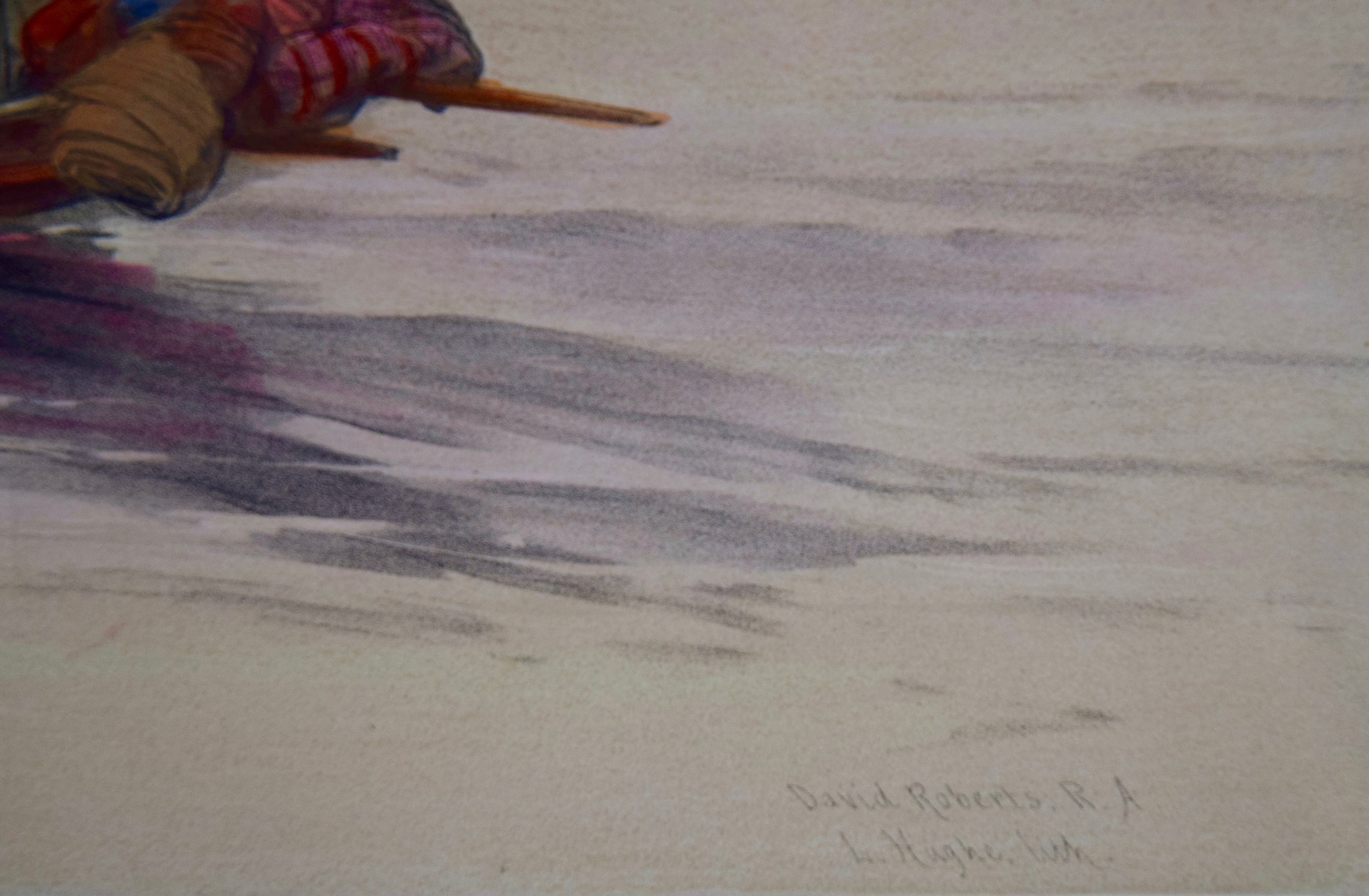Temple of Hathor, Dendera Egypt: David Roberts' 19th C. Hand-colored Lithograph
This is an original 19th century hand-colored lithograph entitled "View from Under the Portico of the Temple of Dendera" by David Roberts, from his Egypt and Nubia volumes of the large folio edition, published in London by F. G. Moon in 1849. The lithographs were prepared by Louis Haghe (1806-1885) from drawings and paintings by Roberts. The resultant large folio editions of 'The Holy Land' and 'Egypt & Nubia' are considered the greatest lithographically illustrated works issued in the 19th century.
Creator: David Roberts (1796-1864, British)
Creation Year: 1849
Dimensions: Height: 24 in (60.96 cm)
Width: 17 in (43.18 cm)
Medium: Lithograph
Condition: See description below.
Reference #: 4676
This is an original 19th century hand-colored lithograph entitled "View from Under the Portico of the Temple of Dendera" by David Roberts, from his Egypt and Nubia volumes of the large folio edition, published in London by F. G. Moon in 1849. The lithographs were prepared by Louis Haghe (1806-1885) from drawings and paintings by Roberts. The resultant large folio editions of 'The Holy Land' and 'Egypt & Nubia' are considered the greatest lithographically illustrated works issued in the 19th century.
Creator: David Roberts (1796-1864, British)
Creation Year: 1849
Dimensions: Height: 24 in (60.96 cm)
Width: 17 in (43.18 cm)
Medium: Lithograph
Condition: See description below.
Reference #: 4676
This is an original 19th century hand-colored lithograph entitled "View from Under the Portico of the Temple of Dendera" by David Roberts, from his Egypt and Nubia volumes of the large folio edition, published in London by F. G. Moon in 1849. The lithographs were prepared by Louis Haghe (1806-1885) from drawings and paintings by Roberts. The resultant large folio editions of 'The Holy Land' and 'Egypt & Nubia' are considered the greatest lithographically illustrated works issued in the 19th century.
Creator: David Roberts (1796-1864, British)
Creation Year: 1849
Dimensions: Height: 24 in (60.96 cm)
Width: 17 in (43.18 cm)
Medium: Lithograph
Condition: See description below.
Reference #: 4676
The print depicts a view of the imposing Temple of Hathor within the temple complex of Dendera along the Nile River in Egypt. Egyptian men conversing at the entry to the hall provide a perspective as to the mammoth size of the structure. The columns are adorned with beautiful paintings, carvings and hieroglyphs. The details of the face of the Goddess Hathor, seen at the the top of the columns, were obliterated by early Christians. The temple has been modified on the same site starting as far back as the Middle Kingdom, and continuing right up until the time of the Roman emperor Trajan. The existing structure began construction in the late Ptolemaic period at the time of Ptolemy Auletes in July 54 BCE and the hypostyle hall was built in the Roman period under Tiberius. It is one of the best-preserved temple complexes in Egypt.
This hand-colored lithograph print is printed on wove paper with wide margins. The sheet measures 24" high and 17" wide. There is a tiny faint barely perceptible spot in the upper portion of the right margin and a minimal bump to the lower right corner of the sheet. The print is otherwise in excellent condition.
Provenance: This exceptional lithograph was previously owned by George Edwin Bergstrom, architect for the Pentagon.
Dandera is a vast temple complex near Luxor, Egypt. It is part of the ancient city of Thebes. Construction of the complex began during the reign of Senusret I around 2000–1700 BCE and was completed in the Ptolemaic Kingdom (305–30 BCE).
The drawings and watercolours from Roberts' tour of the Holy Land and Egypt were collated together into folios and released over a seven year period by the publisher F.G. Moon from 20 Threadneedle Street London. This lithograph is from the Royal Subscription Edition (1842-1849) with only 500 copies produced per depiction. Louis Haghe (the Belgian engraver and friend of Roberts) worked on all of the lithographs for this series.
David Roberts (1796-1864) was born outside of Edinburgh, Scotland. At age 10 he became a house painter’s apprentice. He continued painting houses and eventually theater scenes in Edinburgh and then in London. His friend, J. M. W. Turner, recognized his artistic talent and encouraged him to become a full-time artist.
In 1839 Roberts traveled to Egypt and then in 1840, through the Holy Land, concluding in Jerusalem. Upon his return to England, F. G. Moon agreed to publish lithographs created by Louis Haghe from Robert’s sketches and watercolors. This publication was highly acclaimed and very popular for its esthetic quality, its historical and topographical accuracy, and Robert’s dramatic depiction of his scenes. Queen Victoria and Charles Dickens were among the subscribers who collected his works. Roberts' and Haghe’s duotone lithographs, often colored, remain extremely sought-after today and have been rising steadily in value.




































